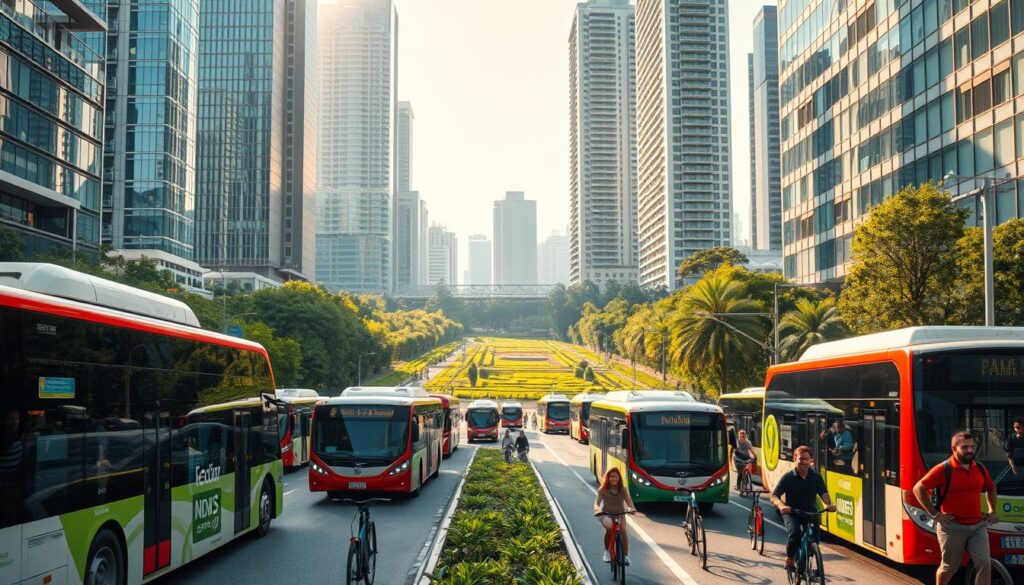Can our nation’s transportation systems withstand the increasing threats of climate change?
Our economy depends heavily on robust networks to move goods and raw materials across the country and around the world. However, the impacts of climate change, such as more frequent and severe flooding, heat waves, and sea level rise, are causing significant disruptions and damage to roads, bridges, and other critical infrastructure.
The Steps to Resilience framework offers a valuable approach for governments to identify climate-related hazards and take effective actions to reduce risk, ensuring that our transportation systems remain reliable and efficient.
Key Takeaways
- Climate change poses significant challenges to transportation systems, causing disruptions and damage.
- Resilient transportation infrastructure is crucial for the economy and national security.
- Governments can use the Steps to Resilience framework to identify and mitigate climate-related risks.
- Investing in resilient transportation systems can help reduce the economic impacts of climate change.
- Adaptation options can be identified to address vulnerabilities and ensure transport investments deliver their intended benefits.
Understanding Transportation Infrastructure Resilience
Resilience in transportation infrastructure refers to the ability of transportation systems to withstand and recover from disruptions. According to the definition, “Resilience is the capacity of a community, business, or natural environment to prevent, withstand, respond to, and recover from a disruption.” This concept is crucial in today’s world, where transportation systems are increasingly vulnerable to various threats, including natural disasters and man-made disruptions.
Enhancing infrastructure resilience involves implementing infrastructure resilience strategies that can mitigate the impact of such disruptions. This includes designing transportation systems that are adaptable and can quickly respond to changing conditions.
Definition of Resilience in Transportation
Resilience in transportation is about more than just withstanding disruptions; it’s also about the ability to recover quickly. As noted in a report on transportation resilience,
“The goal is to create transportation systems that can absorb, adapt to, and quickly recover from disruptions.”
This involves a comprehensive approach that includes planning, design, and operation of transportation infrastructure.
For more detailed information on transportation resilience, refer to the Transportation Resilience Report, which outlines key strategies for enhancing infrastructure resilience.
Importance of Resilience in Urban Planning
The importance of resilience in urban planning cannot be overstated. Urban areas are hubs of economic activity, and their transportation systems are critical to their functioning. By incorporating enhancing infrastructure resilience into urban planning, cities can reduce the risk of disruptions and ensure that their transportation systems remain operational.
Urban planners can adopt various strategies to enhance resilience, including the use of smart transportation technologies and sustainable materials. For insights into innovative approaches to transportation network engineering, visit World Civil Society.
The Current State of U.S. Transportation Infrastructure
The U.S. transportation infrastructure is at a critical juncture, facing numerous challenges that impact its resilience and sustainability. As the backbone of the American economy, the need for effective transportation infrastructure planning has never been more pressing.
The impacts of climate change present a significant and growing risk to the safety, reliability, and sustainability of transportation infrastructure and operations. According to a report, U.S. transportation faces a challenging route ahead, with aging infrastructure and increasing weather-related disruptions highlighting the need for resilient infrastructure.

Overview of Existing Infrastructure
The existing U.S. transportation infrastructure is a complex network of roads, bridges, airports, and public transportation systems. While it has been crucial in supporting economic growth, it is showing signs of strain due to age and increased demand. The need for resilient infrastructure development is evident, with a focus on adapting to the challenges posed by climate change.
Challenges Facing Transportation Systems
Transportation systems across the U.S. are facing multiple challenges, including the impacts of extreme weather events, aging infrastructure, and increased traffic congestion. Addressing these challenges requires innovative solutions and a commitment to transportation infrastructure planning that prioritizes resilience and sustainability.
By understanding these challenges and the current state of U.S. transportation infrastructure, we can begin to develop strategies for improving its resilience and ensuring its continued ability to support the economy and public well-being.
The Role of Climate Change
Climate change is increasingly recognized as a critical factor in shaping the resilience of transportation infrastructure. As the planet warms, the frequency and intensity of extreme weather events are escalating, posing significant challenges to the reliability and capacity of transportation systems.
Changes in climatic conditions affect transportation infrastructure in various ways, including rising air temperatures, altered precipitation patterns, increased flooding, sea level rise, storm surges, and drought. According to recent studies, these changes can have devastating impacts on transportation networks, causing disruptions, damage, and economic losses. As U.S. transportation infrastructure is a critical backbone of the economy, enhancing its resilience is paramount.
Impact of Extreme Weather on Transportation
Extreme weather events, such as hurricanes, floods, and heatwaves, can severely impact transportation infrastructure. For instance, flooding can damage roads and bridges, while heatwaves can cause pavement degradation and affect the integrity of rail tracks. The resilience of civil engineering projects is crucial in mitigating these impacts.
Moreover, the increased frequency of such events due to climate change necessitates a proactive approach to adapting and strengthening transportation infrastructure. This involves not only repairing damaged infrastructure but also implementing measures to enhance its resilience to future events.
Adapting Infrastructure for Climate Resilience
Adapting transportation infrastructure to the challenges posed by climate change requires a multifaceted approach. This includes incorporating climate resilience into infrastructure design, using materials and construction methods that can withstand extreme weather conditions, and implementing smart technologies to monitor and manage infrastructure performance.
As noted by experts, “Investing in resilient infrastructure is not just a matter of protecting our transportation systems; it’s also about ensuring the continuity of our economy and the well-being of our communities.” Enhancing sustainable transportation resilience is key to achieving these goals.
“The transportation sector must be prepared to adapt to the changing climate conditions, requiring innovative solutions and collaborative efforts among stakeholders.”
By prioritizing improving transport infrastructure resilience and adopting sustainable practices, we can build transportation systems that are not only more resilient to climate change but also more sustainable and efficient.
Technological Advancements
As we move forward, the role of technological innovations in building resilient transportation systems cannot be overstated. The integration of advanced technologies is crucial for enhancing transport infrastructure resilience and ensuring that transportation networks can withstand and recover from disruptions.

Smart Transportation Solutions
Smart transportation solutions are pivotal in creating adaptable and responsive transportation systems. These solutions leverage real-time data, IoT devices, and advanced analytics to monitor and manage traffic flow, predict maintenance needs, and optimize traffic signal timing. By implementing such infrastructure resilience strategies, cities can reduce congestion, lower emissions, and improve overall safety.
For instance, intelligent transportation systems (ITS) can dynamically adjust traffic signal timings based on real-time traffic conditions, reducing congestion and minimizing the risk of accidents. Moreover, smart traffic management systems can quickly respond to incidents, such as accidents or natural disasters, by rerouting traffic and providing critical information to commuters.
Innovations in Sustainable Materials
Innovations in sustainable materials are another critical aspect of building resilient transportation infrastructure. The use of recycled materials, such as recycled asphalt pavement (RAP) and recycled concrete aggregate (RCA), not only reduces waste but also conserves natural resources. Additionally, the development of new materials, like fiber-reinforced polymers (FRP) and advanced composites, offers enhanced durability and resistance to environmental degradation.
These sustainable materials can significantly extend the lifespan of transportation infrastructure, reducing the need for frequent repairs and replacements. Furthermore, they can contribute to enhancing transport infrastructure resilience by providing better resistance to extreme weather events and other disruptions.
Federal and State Policies
Federal and state governments play a pivotal role in shaping the future of transportation infrastructure through informed policies. Effective policies are crucial for enhancing transportation infrastructure resilience, especially in the face of climate change and its impacts on transportation systems.
Key Legislation Affecting Transportation Resilience
Recent legislation has underscored the importance of resilience in transportation infrastructure. For instance, the Infrastructure Investment and Jobs Act includes provisions aimed at enhancing the resilience of transportation systems. Such legislation provides a framework for investing in infrastructure that can withstand the challenges posed by extreme weather events and other disruptions.
Governments have an important role to play in achieving deep GHG emission reductions and building resilience to the impacts of climate change. By enacting and implementing policies that support resilient transportation systems, governments can help ensure that transportation infrastructure remains viable and effective over the long term.
Funding Opportunities for Resilient Infrastructure
Funding is a critical component of building resilient transportation infrastructure. Various funding opportunities are available at the federal and state levels to support projects that enhance resilience. These include grants, loans, and other financial assistance programs designed to help transportation agencies and other stakeholders invest in resilient infrastructure.
By leveraging these funding opportunities, transportation agencies can implement projects that not only improve the resilience of their infrastructure but also contribute to the overall sustainability of their systems. It’s essential for agencies to stay informed about available funding sources and to develop projects that are competitive for these funds.
Community Involvement
The resilience of transportation infrastructure is significantly enhanced when community stakeholders are actively involved in the planning process. Understanding the vulnerability of the transportation system is the first step to making it more resilient.
Engaging the community in infrastructure planning not only fosters a sense of ownership but also ensures that the solutions developed are tailored to the specific needs of the area. This collaborative approach can lead to more effective and sustainable infrastructure resilience strategies.
Engaging Stakeholders in Infrastructure Planning
Stakeholder engagement is a critical component of infrastructure planning. It involves not just government agencies and private companies, but also the local community, advocacy groups, and other interested parties. By engaging stakeholders, planners can gather valuable insights into the needs and concerns of the community.
“Public participation is essential for creating transportation systems that are responsive to the needs of all users.”
This inclusive approach helps in identifying potential issues early on and developing solutions that are more likely to be accepted and supported by the community.
| Stakeholder Group | Role in Infrastructure Planning | Benefits of Engagement |
|---|---|---|
| Local Community | Provides insights into local needs and concerns | More tailored and effective solutions |
| Private Companies | Contributes financial and technical resources | Innovative solutions and shared risk |
| Government Agencies | Oversees regulatory compliance and funding | Ensures projects meet legal and safety standards |
Benefits of Public-Private Partnerships
Public-private partnerships (PPPs) have emerged as a powerful tool in enhancing infrastructure resilience. By combining the strengths of both sectors, PPPs can deliver projects that are more efficient, innovative, and sustainable.
Key benefits of PPPs include:
- Increased efficiency through private sector expertise
- Access to additional funding sources
- Innovative solutions driven by private sector competition
- Shared risk between public and private partners
By leveraging PPPs, communities can enhance their infrastructure resilience while also promoting economic growth and development.

In conclusion, community involvement is a vital element in building resilient transportation infrastructure. By engaging stakeholders and leveraging public-private partnerships, communities can develop infrastructure that is not only more resilient but also more responsive to the needs of its users.
Case Studies of Successful Resiliency Projects
Successful resiliency projects are being led by cities like New York and Miami, showcasing effective strategies. These cities have taken proactive steps to enhance their transportation infrastructure planning, ensuring resilience against climate-related hazards.
Lessons from New York City’s Resilience Efforts
New York City has been at the forefront of resilient infrastructure development. The city’s comprehensive approach includes upgrading its transportation systems to withstand extreme weather events. For instance, the Resilient Infrastructure Development initiative focuses on protecting critical infrastructure from flooding and sea-level rise.
One notable example is the Rebuild by Design project, which has implemented innovative flood protection measures. This project demonstrates the city’s commitment to adapting its infrastructure for climate resilience.
| Project | Key Features | Benefits |
|---|---|---|
| Rebuild by Design | Flood protection measures, green infrastructure | Enhanced resilience, reduced flood risk |
| Resilient Infrastructure Development | Upgraded transportation systems, sea-level rise protection | Improved infrastructure durability, climate adaptability |
Innovative Solutions in Miami’s Flood Management
Miami has also made significant strides in resilient infrastructure development, particularly in flood management. The city’s Flood Management Initiative includes a range of innovative solutions, such as sea walls and pumped storage systems, to mitigate the impact of flooding.
Miami’s approach highlights the importance of community involvement in infrastructure planning. By engaging stakeholders, the city has been able to develop solutions that are both effective and sustainable.
The Steps to Resilience framework, which describes an approach for governments to identify valuable assets and take effective actions to reduce risk, has been instrumental in guiding these cities’ efforts. By adopting this framework, cities can develop comprehensive resiliency plans that address their unique challenges.
Integrating Sustainable Practices
Building resilient transportation infrastructure requires a multifaceted approach that incorporates sustainable design and practices. As we move towards a more sustainable future, it’s essential to integrate climate change considerations into asset management to enhance transport infrastructure resilience.
Eco-Friendly Design in Transportation Projects
Eco-friendly design plays a crucial role in reducing the environmental footprint of transportation projects. This involves using sustainable materials and innovative design techniques to minimize environmental impact. For instance, using recycled materials in road construction or designing green infrastructure can significantly reduce the carbon footprint of transportation projects.
Some key strategies for eco-friendly design include:
- Using locally sourced materials to reduce transportation emissions
- Incorporating green spaces into infrastructure design
- Implementing energy-efficient lighting systems
- Designing infrastructure that works with natural environments rather than against them
For more information on sustainable building materials, visit World Civil Society.
Reducing Environmental Impact of Infrastructure
Reducing the environmental impact of infrastructure is critical for achieving sustainable transportation resilience. This can be achieved through various measures, including the adoption of sustainable practices during the construction phase and the implementation of green technologies.
Some effective strategies for reducing environmental impact include:
- Conducting thorough environmental impact assessments before project commencement
- Implementing waste reduction and recycling programs during construction
- Using renewable energy sources to power infrastructure
- Designing infrastructure with longevity and adaptability in mind to reduce the need for frequent repairs or replacements
As discussed in a related article on The Intersection of Sustainability and Resilience in, integrating sustainability into infrastructure development is key to enhancing resilience.

By integrating sustainable practices into transportation infrastructure development, we can create more resilient and environmentally friendly transportation systems. This not only benefits the environment but also enhances the quality of life for communities by providing safer, more efficient transportation options.
Future Trends
Transportation infrastructure is on the cusp of a revolution, driven by technological advancements and changing environmental conditions. As we look ahead, it’s essential to understand the emerging trends that will shape the future of transportation.
Emerging Technologies in Transportation Resilience
The integration of emerging technologies is set to transform transportation infrastructure, making it more resilient and efficient. Some of the key technologies include:
- Artificial Intelligence (AI): AI can enhance predictive maintenance, allowing for the early detection of potential failures and reducing downtime.
- Internet of Things (IoT): IoT devices can monitor infrastructure conditions in real-time, providing valuable data for maintenance and operations.
- Advanced Materials: New materials and construction techniques are being developed to improve the durability and sustainability of transportation infrastructure.
These technologies will play a crucial role in improving transport infrastructure resilience by enabling proactive maintenance, reducing the risk of failures, and enhancing the overall efficiency of transportation systems.
Forecasting Future Transportation Needs
Forecasting future transportation needs is critical for planning and developing infrastructure that meets the demands of a growing population and changing environmental conditions. This involves analyzing demographic trends, economic forecasts, and environmental projections to anticipate future transportation requirements.
Effective forecasting enables transportation planners to develop infrastructure resilience strategies that are tailored to the specific needs of their region, ensuring that transportation systems are prepared for future challenges.
By leveraging data and emerging technologies, transportation planners can create more resilient and sustainable infrastructure, ultimately enhancing the quality of life for communities and supporting economic growth.
Balancing Cost and Resilience
The key to resilient transportation systems lies in striking a balance between cost-effectiveness and future-proofing infrastructure. Building resilience in the transportation sector can help cities recover from a range of events, from natural disasters to economic downturns. This balance is crucial for ensuring that transportation infrastructure remains functional and efficient over its lifespan.
Budgeting for Long-Term Infrastructure Investment
Effective budgeting for transportation infrastructure involves considering both the short-term costs and the long-term benefits of resilient design. Investing in resilient infrastructure may require higher upfront costs, but it can significantly reduce maintenance and repair costs over time. Cities can adopt a lifecycle cost analysis approach to evaluate the total cost of ownership for their transportation infrastructure, making informed decisions that balance initial expenditure with long-term savings.
Moreover, cities can explore various funding mechanisms, such as public-private partnerships (P3s), to finance resilient infrastructure projects. P3s can bring in private sector efficiency and innovation, helping to deliver projects that are both cost-effective and resilient.
Cost-Effective Resilience Strategies
Implementing cost-effective resilience strategies is vital for transportation infrastructure. One approach is to incorporate green infrastructure, such as green roofs and permeable pavements, which can help manage stormwater runoff and reduce the risk of flooding. Another strategy is to use advanced materials and technologies that enhance the durability and adaptability of transportation infrastructure.
Additionally, cities can adopt a phased implementation approach, prioritizing the most critical infrastructure upgrades and resilience measures. This approach allows cities to manage costs while still advancing their resilience goals.

By adopting a balanced approach to cost and resilience, cities can create transportation infrastructure that is not only financially sustainable but also capable of withstanding future challenges. This involves a combination of smart budgeting, cost-effective resilience strategies, and a commitment to long-term infrastructure investment.
Education and Training
To ensure the long-term viability of transportation systems, it is essential to invest in education and training initiatives that foster infrastructure resilience.
Understanding the vulnerability of the transportation system is the first step to making it more resilient. Education and training play a pivotal role in this process by equipping the workforce with the knowledge and skills necessary to implement infrastructure resilience strategies.
Workforce Development for Resilient Infrastructure
Developing a skilled workforce is critical for building and maintaining resilient transportation infrastructure. This involves:
- Creating comprehensive training programs that focus on the latest technologies and methodologies in infrastructure resilience.
- Encouraging collaboration between educational institutions and industry stakeholders to ensure that the curriculum meets the current needs of the sector.
- Promoting continuous professional development to keep the workforce updated on best practices in enhancing infrastructure resilience.
Promoting Awareness about Infrastructure Resilience
Raising awareness about the importance of infrastructure resilience is vital for garnering support from stakeholders and the public. This can be achieved by:
- Organizing workshops and seminars to educate stakeholders about the benefits of resilient infrastructure.
- Utilizing media and digital platforms to disseminate information on successful resilience projects and strategies.
- Developing guidelines and resources, such as the Vision Document, to provide a framework for enhancing infrastructure resilience.
By focusing on education and training, we can build a more resilient transportation infrastructure that is capable of withstanding future challenges.
Regional Considerations
Regional considerations play a crucial role in building resilient transportation infrastructure. Different regions face unique challenges due to their geographical characteristics, climate, and population density.
Urban vs. Rural Infrastructure Needs
Urban and rural areas have distinct infrastructure needs. Urban areas require more complex transportation systems to manage high volumes of traffic, while rural areas need infrastructure that can withstand harsh weather conditions and support agricultural transportation.
Climate change is causing more frequent weather events, such as flooding and snowstorms, which affect both urban and rural transportation networks. The Chicago Metropolitan Agency for Planning highlights the importance of improving the resilience of transportation networks to weather events and climate change.
By understanding these regional differences and adapting infrastructure plans accordingly, we can create more resilient transportation systems that support the needs of both urban and rural communities.
